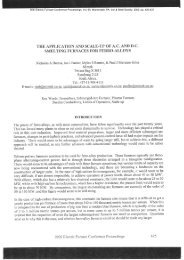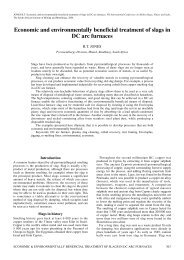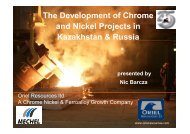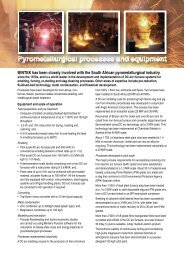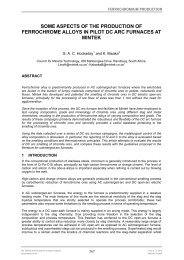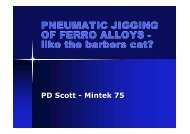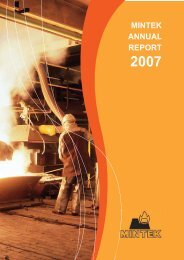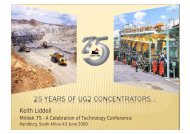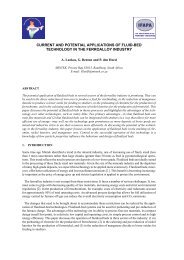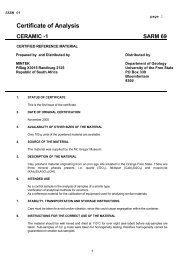Furnace refractory erosion - Mintek
Furnace refractory erosion - Mintek
Furnace refractory erosion - Mintek
You also want an ePaper? Increase the reach of your titles
YUMPU automatically turns print PDFs into web optimized ePapers that Google loves.
3. A.F.S Schoukens, L.R. Nelson and N.A. Barcza, “Plasma-arc treatment of steel-plant dust and zinccontainingslag—Theoretical and practical considerations,” in Recycling Lead and Zinc: The Challengesof the 1990’s, International Lead and Zinc Study Group, London, 1991, pp. 361–70.4. A.F.S. Schoukens, F. Shaw and E.C. Chemaly, “The Enviroplas process for the treatment of steel-plantdusts,” J. S. Afr. Inst. Min. Metall., Vol. 93, No. 1, Jan. 1993, pp. 1–7.5. A.F.S. Schoukens, G.M. Denton and R.T. Jones, “Pilot-plant production of prime western grade zincfrom lead blast-furnace slags using the Enviroplas process,” in P.B. Queneau and R.D. Peterson (eds),Third International Symposium, Recycling of Metals and Engineered Materials, The Minerals, Metals &Materials Society, Warrendale, Penn., 1995, pp. 857–68.6. N.A. Barcza, D.G.C. Robertson, A.F.S. Schoukens, F. Shaw, G.M. Denton, T.W. Worcester and D.J.Bailey, “Enviroplas technology for the recovery of lead and zinc from lead blast furnace slags,” inRecycling Lead and Zinc into the 21st Century, International Lead and Zinc Study Group, London,1995, pp. 73–89.7. H. Lagendijk and R.T. Jones, “Production of ferronickel from nickel laterites in a DC-arc furnace,” inC. Díaz, I. Holubec and C.G. Tan (eds) Pyrometallurgical Operations, the Environment and VesselIntegrity in Nonferrous Smelting and Converting, Proceedings of the Nickel-Cobalt 97 InternationalSymposium—Volume III, Canadian Institute of Mining, Metallurgy and Petroleum, Montreal, 1997,pp. 151–62.8. S. Jahanshahi, D. Xie and T. Tran, “In-situ gravimetric studies of wetting, penetration and wear ofrefractories by molten slags,” in Sixth International Conference on Molten Slags, Fluxes and Salts,Department of Materials Science and Engineering, KTH, Sweden, 2000, 18 pp.9. M. Hayase, “Introduction to refractories: Definition and classification,” in C.E. Semler, J. Homeny, G.Hand, G. MacZura and M. Madono (eds) Refractories Handbook, The Technical Association ofRefractories, Japan, Tokyo, 1998, pp. 2–7.10. H. Tada, “Carbon containing refractories: Magnesia-carbon,” in C.E. Semler, J. Homeny, G. Hand, G.MacZura and M. Madono (eds) Refractories Handbook, The Technical Association of Refractories,Japan, Tokyo, 1998, pp. 170–82, 189–90.11. A. Muan and E.F. Osborn, Phase Equilibria Among Oxides in Steelmaking, Addison-Wesley PublishingCo., Reading, Mass., 1965.12. M. Kowalski, P.J. Spencer and D. Neuschütz, “Phase diagrams,” in D. Springorum/VDEh (eds) SlagAtlas, 2nd edition, Verlag Stahleisen, Düsseldorf, 1995, pp. 21–214.13. K. Mukai, “Wetting and Marangoni effect in iron and steelmaking processes,” ISIJ Int. Vol. 32, No. 1,1992, pp. 19–25.14. J.R. Donald, P.H. Lauzon, S.W. Ip and J. Duran, “Investigations into <strong>refractory</strong> wear at Cerro MatosoS.A.,” CIM Bull. Vol. 92, 1999, pp. 124–30.15. O. Knacke, O. Kubaschewski and K. Hesselmann (eds), Thermochemical Properties of InorganicSubstances, 2nd edition, Springer-Verlag, Berlin, 1991.16. B.J. Page and G.W. Loar, “Chromium compounds,” in J.I. Kroschwitz and M. Howe-Grant (eds) Kirk-Othmer Encyclopedia of Chemical Technology, Volume 6, John Wiley & Sons, New York, 1993,pp. 263–311.2000 ELECTRIC FURNACE CONFERENCE PROCEEDINGS 378



